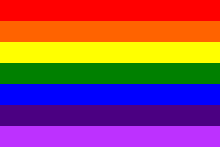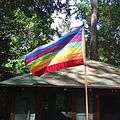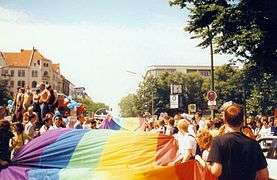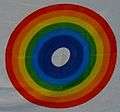Rainbow flag

A rainbow flag is a multicolored flag consisting of the colors of the rainbow. The actual colors shown differ, but many of the designs are based on the traditional scheme of red, orange, yellow, green, blue, indigo, and violet, or some more modern division of the rainbow spectrum (often excluding indigo, and sometimes including cyan instead).
There are several independent rainbow flags in use today. The most widely known worldwide is the pride flag representing LGBT pride (since 1978). The peace flag is especially popular in Italy (since 1961). The International Co-operative Alliance adopted a rainbow flag in 1925. A similar flag is used in Andean indigenism in Peru and Bolivia to represent the legacy of the Inca Empire (since ca. 1920).
Rainbow flags in various cultures and movements
Reformation
The reformer Thomas Müntzer (1489–1525) connected socially revolutionary claims with his preaching of the gospel. He is often portrayed with a rainbow flag in his hand. The Thomas Müntzer statue in the German town of Stolberg also shows him holding a rainbow flag in his hand. In the German Peasants' War of the 16th century, the rainbow flag together with the peasants' boot ("Bundschuh") was used as the sign of a new era, of hope and of social change. The choice of the rainbow in the form of a flag harkens back to the rainbow as a symbol of biblical promise. According to the Bible, God first created the rainbow as a sign to Noah that there would never again be a worldwide flood,[1][2] also known as the Rainbow covenant.
Thomas Paine
American Revolutionary War writer Thomas Paine had proposed that the rainbow flag be used as a maritime flag, to signify neutral ships in time of war.[3][4][5]
Buddhist flag (1885)
A flag to represent Buddhism was designed in Sri Lanka in 1885 and modified to its current form in 1886. In 1950 it was adopted by the World Fellowship of Buddhists to be a symbol of all forms of Buddhism around the world.
It consists of six vertical colored segments, the first five of which are usually blue, yellow, red, white, and orange, while the sixth is a combination of the first five. Variant colors are often found.
First Armenian Republic proposal (1919)

Rainbow flag proposed after Armenia regained independence after World War I. It was designed by famous Armenian artist Martiros Saryan. It was not adopted as the country instead went with three stripes using the colors used in a past Armenian kingdom. The artists used muted, richer, "oriental" colors reflecting Armenian fabrics and carpets.
Cooperative movement (1921)

A seven-colour rainbow flag is a common symbol of the international cooperative movement. The rainbow flag has been the cooperative emblem since 1921 when the International Co-operative Congress of World Co-op Leaders met in Basel, Switzerland to identify and define the growing cooperative movement’s common values and ideals to help unite co-ops around the world.
In Essen, Germany in 1922, the International Co-operative Alliance (ICA) designed an international co-op symbol and a flag for the first "Co-operators' Day," which was held in July 1923. After some experiments with different designs, a famous French cooperator, Professor Charles Gide, suggested using the seven colours of the rainbow for the flag. He pointed out that the rainbow symbolized unity in diversity and the power of light, enlightenment and progress. The first co-op rainbow flag was completed in 1924 and was adopted as an official symbol of the international cooperative movement in 1925.
In 2001, the ICA's official flag was changed from a rainbow flag to a rainbow logo flag on a white field, to clearly promote and strengthen the cooperative image, but still use the rainbow image. Other organizations sometimes use the traditional rainbow flag as a symbol of cooperation.
Like the rainbow, this flag is a symbol of hope and peace. The seven colours from flags around the world fly in harmony. Each of the seven colours in the co-operative flag have been assigned the following meaning:
- red: stands for courage;
- orange: offers the vision of possibilities;
- yellow: represents the challenge that GREEN has kindled;
- green: indicates a challenge to co-operators to strive for growth of membership and of understanding of the aims and values of co-operation;
- light blue: suggests far horizons, the need to provide education and help less fortunate people and strive toward global unity.
- dark blue: suggests pessimism: a reminder that less fortunate people have needs that may be met through the benefits of cooperation.
- violet: is the colour of warmth, beauty, and friendship.
The ICA has been flying a flag with its official logo since April 2001, when its Board decided to replace the traditional rainbow flag. Its use by a number of non-cooperative groups led to confusion in several countries around the world.
— ICA, [6]
Andean indigenism (1920s)

A flag with a seven-striped rainbow design is used in Peru,[7] Bolivia and Ecuador is anachronically associated with Tawantin Suyu, or Inca territory. The Flag of Cusco was introduced in 1978 and is still the official city emblem.
In reaction to claims as to the flag's "historicity" in the 16th-century Inca Empire, the use of similar rainbow flags has been traced to the early decades of the 1920s. According to Peruvian historiography, the Inca Empire never had a flag. María Rostworowski, a Peruvian historian known for her extensive and detailed publications about Peruvian Ancient Cultures and the Inca Empire, said about this: "I bet my life, the Inca never had that flag, it never existed, no chronicler mentioned it".[8] Also, according to the Peruvian newspaper El Comercio, the flag only dates to the first decades of the 20th century,[9] and even the Congress of the Republic of Peru has determined that flag is a fake by citing the conclusion of the National Academy of Peruvian History:
"The official use of the wrongly called 'Tawantinsuyu flag' is a mistake. In the pre-Hispanic Andean world the concept of flags did not exist, it did not belong to their historic context".[10]
National Academy of Peruvian History
In Ecuador, a rainbow flag is used by the Pachakutik political party (1995), which is composed mostly of left-wing indigenous people.
Meher Baba (1924)

Meher Baba designed a rainbow flag on April 23, 1924. It is flown each year near his samadhi (tomb-shrine) in Meherabad, India during the week of Amartithi (the anniversary of his death on January 31, 1969). Baba explained the symbolism, saying, "The colors in the flag signify man's rise from the grossest of impressions of lust and anger – symbolized by red – to the culmination in the highest state of spirituality and oneness with God – symbolized by sky blue." [11][12]
Peace movement (1961)
This rainbow flag in Italy was first used in a peace march in 1961, inspired by similar multi-coloured flags used in demonstrations against nuclear weapons. It became popular with the Pace da tutti i balconi ("peace from every balcony") campaign in 2002, started as a protest against the impending war in Iraq. The most common variety has seven colours, purple, blue, azure, green, yellow, orange and red, and is emblazoned in bold with the Italian word PACE, meaning "peace".[13][14]
Common variations include moving the purple stripe down below the azure one, and adding a white stripe on top (the original flag from the 60s had a white stripe on top). This flag has been adopted internationally as a symbol of the peace movement.
Bene Ohr Jewish movement, U.S.A. (1961)
In 1961, Rabbi Zalman Schachter-Shalomi designed the rainbow tallit (prayer shawl) as a symbol of the Kabalah for the members of the Jewish Bene Ohr ("The Children of Light"). It is a vertically presented rainbow, with each colour separated by black stripes of varying thicknesses. The colors represent aspects of God; the black stripes and white spaces represent aspects of creation and protection.[15]
LGBT (Lesbian, Gay, Bisexual, Transgender) Pride (1978)

The rainbow flag was popularized as a symbol of the gay community by San Francisco artist Gilbert Baker in 1978. The different colors symbolize diversity in the gay community, and the flag is used predominantly at gay pride events and in gay villages worldwide in various forms including banners, clothing and jewelry. Since the 1990s, its symbolism has been transferred to represent the extended "LGBT" (lesbian, gay, bisexual and transgender) community . For the 25th Anniversary of the Stonewall riots, held in 1994 in New York city, a mile-long rainbow flag was created and post-parade cut up in sections that have since been used around the world.
The flag was originally created with eight colors, but pink and turquoise were removed for production purposes, and since 1979 it has consisted of six colored stripes. It is most commonly flown with the red stripe on top, as the colors appear in a natural rainbow.[16] Aside from the obvious symbolism of a mixed LGBT community, the colors were determined to symbolize: life (red), healing (orange), sunlight (yellow), nature (green), harmony/peace (blue), and spirit (purple/violet).[17] The removed colors stood for sexuality (pink) and art/magic (turquoise).[18]
During the late 1980s and early 1990s, a black stripe was sometimes used to represent the AIDS victims.
Jewish Autonomous Oblast (1996)
Another variation of rainbow flag is used by Jewish Autonomous Oblast, situated in the Far Eastern Federal District of Russia, by the Chinese border. Proportions 2:3. Adopted first of October 1996.[19]
The Jewish Autonomous Oblast has a flag with a seven-colour rainbow. The number of colours is meant to symbolize the seven-branched Jewish Menorah.
Patriots of Russia political party (2005)
Rainbow is used as an element of flag of Patriots of Russia (Russian: Патриоты России, Patrioty Rossii) political party.
Gallery of rainbow flags
 Rainbow "pace" (peace) flag
Rainbow "pace" (peace) flag Greek peace flag
Greek peace flag International Co-operative Alliance's rainbow flag
International Co-operative Alliance's rainbow flag
 Meher Baba's flag
Meher Baba's flag Pakistani flag combined with LGBT flag
Pakistani flag combined with LGBT flag LGBT pride
LGBT pride
(original eight-color version) LGBT pride flag
LGBT pride flag
(seven-color version) LGBT pride flag
LGBT pride flag
(six-color version)
 Flag of the Jewish Autonomous Oblast in Russia
Flag of the Jewish Autonomous Oblast in Russia Flag of Lingua Franca Nova
Flag of Lingua Franca Nova The Rainbow Family of Living Light
The Rainbow Family of Living Light Meher Baba's flag, Silence Day, 2015
Meher Baba's flag, Silence Day, 2015- Six-color version of the LGBT pride flag at Taiwan Pride (2004)
 Marchers carry the LGBT pride flag at the pride parade on Christopher Street Day in Berlin (1997)
Marchers carry the LGBT pride flag at the pride parade on Christopher Street Day in Berlin (1997) Parada Równości, 2006
Parada Równości, 2006 Circular Rainbow Flag of Wu-Wo Tea Ceremony
Circular Rainbow Flag of Wu-Wo Tea Ceremony "Pace da tutti i balconi": peace flags hanging from windows in Milano, Italy, in March 2003
"Pace da tutti i balconi": peace flags hanging from windows in Milano, Italy, in March 2003 Rainbow protest flag used by Not in Our Name
Rainbow protest flag used by Not in Our Name_58.jpg) Statue of Thomas Müntzer waving a rainbow flag in Stolberg, Germany
Statue of Thomas Müntzer waving a rainbow flag in Stolberg, Germany A LGBT flag at Ipanema Beach, Rio de Janeiro, Brazil.
A LGBT flag at Ipanema Beach, Rio de Janeiro, Brazil.
References
| Wikimedia Commons has media related to Rainbow flag. |
- ↑ Christian symbols Glossary
- ↑ Symbol of God's Everlasting Covenant with Mankind
- ↑ New York: A Guide to the Empire State, Federal Writers Project, editors. New York State Historical Association, 1940, page 246 (American Guide Series)
- ↑ online text from New York: A Guide to the Empire State
- ↑ One Life at a Time, Please, Edward Abbey. New York: Henry Holt, 1988, ISBN 0805006036, page 58
- ↑ Official website of ICA
- ↑ Flagspot.net
- ↑ Bandera Gay o Bandera del Tahuantinsuyo Terra.com
- ↑ "La Bandera del Tahuantisuyo" (PDF) (in Spanish). Retrieved 12 June 2009.
- ↑ "La Bandera del Tahuantisuyo" (PDF) (in Spanish). Retrieved 12 June 2009.
- ↑ Lord Meher, by Bhau Kalchuri, Manifestation Inc. 1986, p. 618
- ↑ The History of Meher Baba's Rainbow Flag
- ↑ Bandiere di Pace.org ('Flags of Peace' in Italian)
- ↑ Amnesty International
- ↑ http://upstel.net/~rooster/tallis.html - retrieved 6 December 2011.
- ↑ History of the Gay Pride Rainbow Flag
- ↑ Haag, Matthew (2017-03-31). "Gilbert Baker, Gay Activist Who Created the Rainbow Flag, Dies at 65". The New York Times. ISSN 0362-4331. Retrieved 2017-04-25.
- ↑ Haag, Matthew (2017-03-31). "Gilbert Baker, Gay Activist Who Created the Rainbow Flag, Dies at 65". The New York Times. ISSN 0362-4331. Retrieved 2017-04-25.
- ↑ Jewish Autonomous Region (Russia)